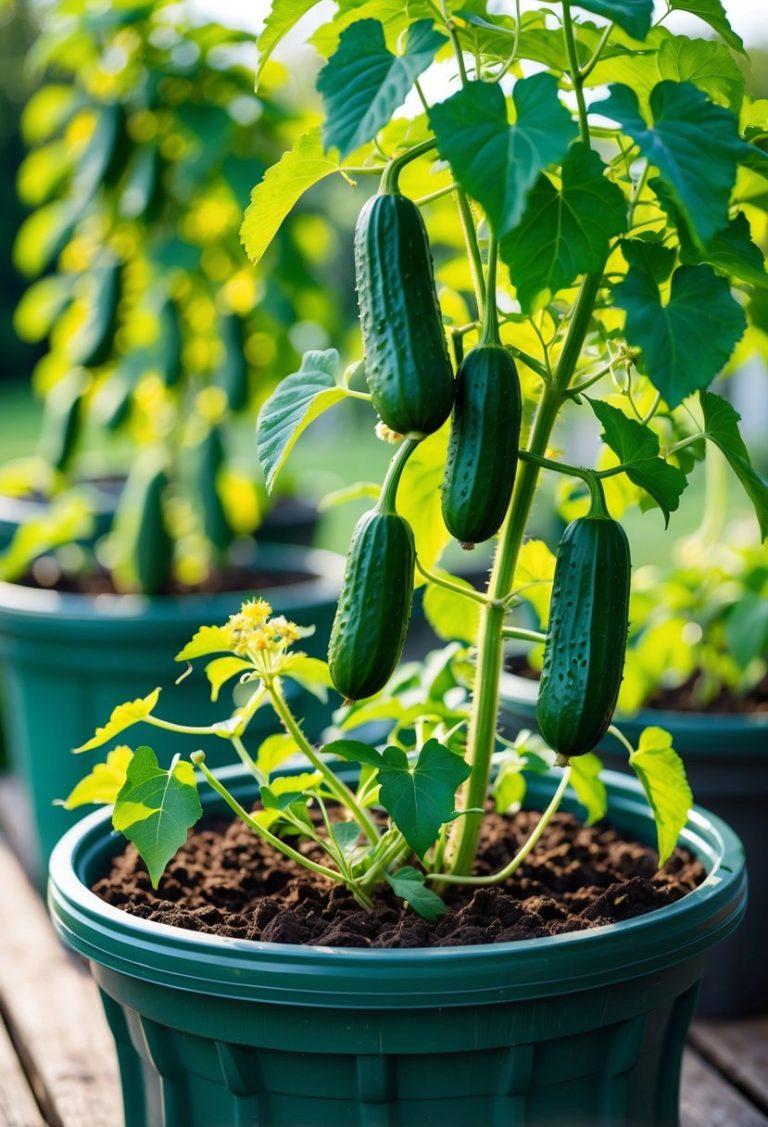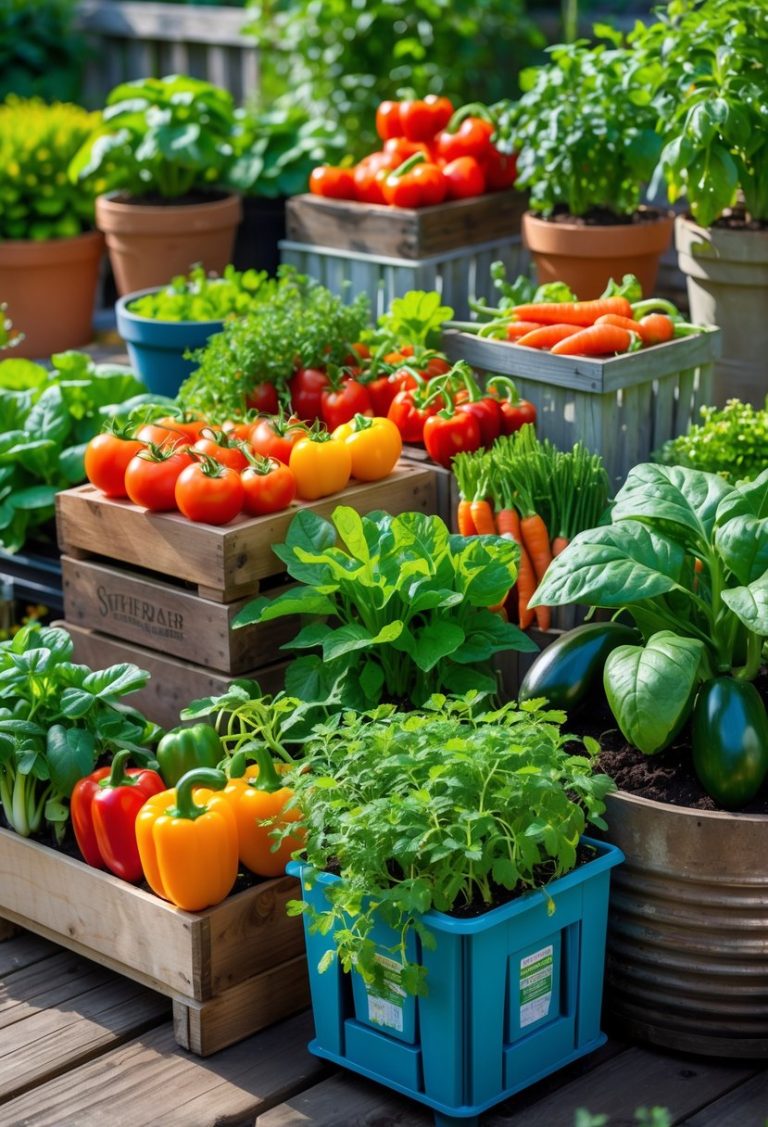Patio Container Gardening Design Tips for Stylish and Efficient Outdoor Spaces
Patio container gardening design is a simple way to transform outdoor spaces into attractive, green retreats. It allows people to bring plants into small or limited areas, making patios look lively and inviting. The key to successful patio container gardening is choosing the right containers and arranging plants thoughtfully to balance beauty and function.

Using containers of the right size, shape, and material can improve plant health and boost the overall look of the space. Selecting plants that suit the environment and complement each other creates an eye-catching display that thrives in patio conditions. Good design also considers easy access for care and maintenance, ensuring the garden remains healthy over time.
With a few smart choices, anyone can turn their patio into a stylish area full of color and life. Understanding how to blend form and function helps achieve a lasting and enjoyable container garden. For more inspiration and practical tips, visit container garden ideas from Better Homes & Gardens.
Key Takeaways
- Proper container selection enhances both plant growth and patio style.
- Plant choices and placement affect the garden’s visual appeal and health.
- Simple care routines support long-term success in container gardening.
Fundamentals of Patio Container Gardening Design

Good patio container gardening depends on using space well and choosing the right plants and containers. Careful planning helps create an attractive and healthy garden, especially for small patios. Proper layout and the right location also affect plant growth and overall appearance.
Essential Principles for Container Layout
Arranging containers with different heights and sizes adds depth and interest. Taller plants go in the back or center, while shorter ones stay in front. Mixing textures and colors brings balance and avoids a flat look.
Using a limited color scheme helps unify the garden visually. Grouping containers on one side or corner can save space and make a small patio feel organized.
Containers should have good drainage and be large enough for roots to grow. Using lightweight pots helps with easy movement and rearranging.
Selecting the Best Location on Patios
Sunlight levels vary on patios, so observing where the sun hits is key. Most plants need at least 4-6 hours of direct sunlight to thrive. Partial shade areas are great for shade-loving plants.
Positioning containers near walls or railings provides wind protection and warmth. It also simplifies watering because the area is more contained.
Access to water sources to keep plants hydrated without hassle is very important. Placing containers close to a faucet or using self-watering pots saves time.
For small patios, vertical space can be used with shelves or hanging containers to maximize plant growth while keeping the floor clear.
More detailed layout and location tips can help improve container gardening for small patios at Garden Design’s container garden ideas.
Choosing Patio Containers for Plants

Selecting the right patio containers affects plant health and the look of a garden. Material, size, and drainage are key factors for container success. Each choice can make a difference in how well plants grow and how easy the containers are to maintain.
Types of Containers and Materials
Patio containers come in many materials, each with pros and cons. Terracotta pots allow air and water to pass through but dry out faster and can crack in cold weather. Plastic containers are lightweight, retain moisture well, and resist breaking but may not offer good breathability.
Ceramic pots often have glazed surfaces that keep moisture in but can be heavy. Metal containers add a modern look but might heat up quickly in the sun, which can stress plants. Some gardeners use reclaimed items like wooden crates or old buckets for a unique style.
The material often impacts watering frequency and durability. Choosing containers with a balance of weight, breathability, and weather resistance is important for patio use.
Sizing and Drainage Considerations
Container size must fit the plant’s root system to allow growth. For most patio plants, a pot should be at least 12 inches wide to hold enough soil and moisture. Small pots dry out quickly, stressing plants. Too large containers make soil stay wet longer and can cause root rot.
Drainage holes are crucial. They prevent water from pooling inside, which can drown roots and lead to disease. If containers lack holes, adding some or using a layer of gravel at the bottom can help drainage.
Some containers come with built-in saucers to catch extra water. Using ones with proper drainage and matching size to plant needs improves health and reduces maintenance effort.
For more details on choosing containers, see this guide on how to choose containers for a container garden.
Plant Selection and Arrangement Strategies

Choosing the right plants and arranging them well are key to successful patio container gardening. The right mix improves appearance and ensures plants thrive together. Matching light and water needs helps keep the garden healthy.
Combining Plants for Visual Appeal
Plants with different shapes, heights, and textures create interest in a container garden. A common strategy is the “thriller, filler, spiller” approach:
- Thriller: A tall, eye-catching plant in the center or back.
- Filler: Mid-height plants that fill space around the thriller.
- Spiller: Trailing plants that hang over the pot edges.
For small patios, compact plants with varied colors work well without crowding. Combining plants that share light and water needs prevents extra care work. For example, pairing petunias (filler) with umbrella sedge (thriller) and sweet potato vine (spiller) results in balanced, colorful containers. More ideas on plant combinations for container gardens can inspire effective mixes.
Seasonal and Climate-Appropriate Choices
Selecting plants suited to your climate and season reduces maintenance and keeps containers thriving. For hot, sunny patios, choose drought-tolerant plants like Dusty Miller and petunias. Cooler or shaded spots might benefit from ferns or begonias.
Changing plants with seasons refreshes the display and avoids overcrowding. Spring and summer favor flowering annuals, while fall and winter allow for evergreens or ornamental grasses. Plants that tolerate similar watering routines should be grouped to avoid under- or over-watering.
More guidance on matching plants to environment can be found at container garden plant selection tips.
Creating Functional and Stylish Patio Spaces

A well-designed patio container garden balances usefulness and beauty. It should use every inch of space smartly while keeping an attractive look that fits the outdoor setting.
Maximizing Space in Small Patios
Small patios need smart use of limited space. Vertical gardening is essential. Using trellises or wall-mounted planters lets plants grow upward, freeing up floor space for seating or walking.
Stacking containers of different sizes can create layers. This allows for more plants without overcrowding. Grouping plants by sunlight needs helps keep them healthy.
Portable containers are useful. They can be moved to create space or avoid weather damage. Choosing multi-purpose furniture with built-in planters adds function without extra clutter.
Color and Texture Coordination
Combining colors and textures creates visual appeal. Using pots with different shapes and finishes, like ceramic and wood, adds depth.
Heavier, solid colors on large containers ground the space, while bright pots highlight small plants. Mixing leafy green plants with ones that have flowers or spiky leaves builds variety.
Consistent color themes in containers unify the look. Green, terracotta, and neutral tones are safe, especially for small patios where too many colors can feel busy.
Blending natural materials with plants supports a calm, inviting patio atmosphere. These choices help make small container gardens functional and stylish.
For ideas on layouts and styles, see container garden layout ideas.
Care, Maintenance, and Long-Term Success

Patio container gardens need regular attention to keep plants healthy and thriving. Care routines that focus on water, nutrients, and problem-solving help maintain vibrant growth and prevent damage.
Watering and Fertilization Tips
Containers dry out faster than garden beds because soil volume is limited. Plants usually need watering daily in hot weather, especially if containers are small or in full sun. It’s best to water deeply until moisture reaches all parts of the soil.
Using a well-balanced, water-soluble fertilizer every two to four weeks supports strong growth. Slow-release fertilizers can also be used but may require occasional supplementation. Always follow package instructions to avoid overfeeding, which can harm plants.
Adjust watering frequency based on the plant type and weather. Succulents and herbs need less moisture than flowering annuals or vegetables. Checking soil moisture daily helps prevent underwatering or root rot from overwatering.
Troubleshooting Common Issues
Yellowing leaves often indicate inconsistent watering or nutrient deficiency. Wilting usually means roots are dry but can also signal root disease. Inspect soil moisture and adjust watering accordingly.
Pests like aphids or spider mites may appear; remove them by spraying plants with water or using insecticidal soap. Regularly check under leaves and around stems, as early detection reduces damage.
Container plants may suffer if roots become cramped. Repotting into larger containers every one or two years helps maintain healthy root systems. Fresh soil refreshes nutrients and improves drainage.
For more detailed care strategies, see 10 Tips for Container Garden Care.
Frequently Asked Questions

Patio container gardening involves choosing the right plants, arranging pots to save space, and avoiding common errors like overcrowding or poor drainage. Cost-effective ideas focus on simple materials and multi-use containers. Vegetable gardens can be made with easy DIY designs, while large container gardens benefit from creative layouts and plant choices.
What are some simple and cost-effective patio container gardening ideas?
Using recycled containers like buckets or wooden crates saves money. Choosing easy-to-grow herbs or flowers reduces maintenance costs. Grouping plants with similar water needs cuts down on waste and effort. Filling pots with affordable soilless blends helps plants thrive without expensive soil.
How can you effectively arrange plant pots on a small patio?
Place taller plants at the back or corners to maximize space and sunlight. Use tiered stands or shelves to add vertical planting areas. Group smaller pots together to create a fuller look without clutter. Leave walking space clear to avoid crowding and allow easy access.
What are the most common mistakes to avoid in patio container gardening?
Choosing containers without drainage holes causes root rot and poor plant health. Overcrowding pots can starve plants of air and nutrients. Using the wrong sized planter hurts growth – too small limits roots, too big wastes soil. Avoid plastic pots if they trap heat under strong sun.
What disadvantages should be considered when starting a patio container garden?
Containers dry out faster than ground soil, so watering is needed more often. Limited soil space restricts plant size and nutrient supply. Pots can be heavy and hard to move when filled with soil. Some plants may not thrive well in confined spaces.
Can you suggest some diy container garden designs for vegetables?
Stacked wooden crates can hold multiple vegetable pots in a small area. Using hanging baskets for leafy greens saves floor space. Simple self-watering containers help maintain moisture levels for tomatoes or peppers. Raised bed containers with good drainage work well for root vegetables.
What are some creative ways to design a large container garden on a patio?
Mix different shapes and heights of pots to create visual interest. Use colorful containers that complement patio decor. Combine edible plants with flowers for both beauty and utility. Incorporate trellises or vertical gardens to grow climbing plants and save space.
For more details on container gardening soil and drainage, visit container garden FAQs here.






